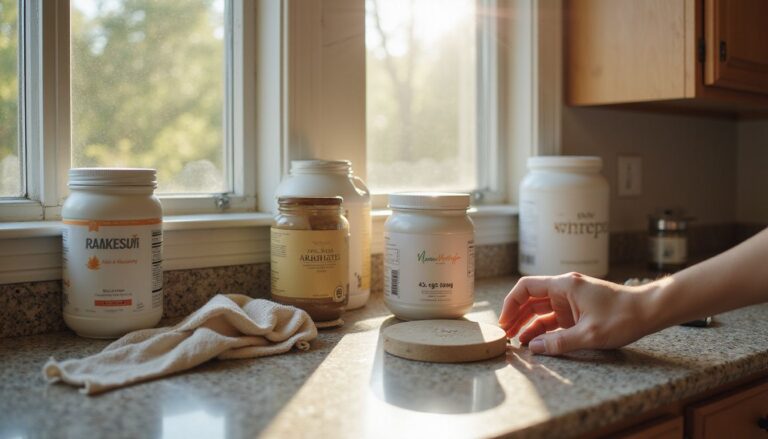Top Low Calorie Protein Bars For A Healthy Energy Boost
Our Nutrition Assistant AI Suite will transform your body. You will lose fat, get toned, and build muscle. Gain confidence and optimal health.
Finding a snack that boosts energy without excess calories can feel tricky. Research suggests low calorie protein bars help manage hunger and support muscle recovery after exercise1. This guide gives you clear tips and brand reviews so you can choose the right protein bar for your goals, whether you want high-protein, vegan, or keto-friendly options.
Use the quick takeaways below, then explore the sections that follow. You will learn how to read labels, compare ingredients, and time your snacks for steady energy.
1 Pasiakos SM et al. Protein supplements and muscle health. Sports Med. 2015.
Key Takeaways
- Most low calorie protein bars offer 10 to 21 grams of protein and 100 to 220 calories per bar. This balance can support energy, weight control, and muscle repair after workouts1.
- Pure Protein Bars provide 19 to 21 grams of protein with about 180 to 200 calories per bar. ALOHA Organic Protein Bars supply 14 grams of plant-based protein with about 220 calories.
- Bulletproof Protein Crisp Bars are keto friendly. Each bar has 11 to 12 grams of protein, 2 to 3 grams net carbs, and collagen that may support joint health.
- RXBAR Protein Bars use simple ingredients and deliver 12 grams of protein and 5 grams of fiber. Natural sugars from dates run about 10 to 15 grams per bar.
- Dietitians, including those at the Mayo Clinic, advise using low calorie protein bars as snacks between meals or around workouts to maintain steady energy.

What are Low-Calorie Protein Bars?

Low calorie protein bars are nutrition bars with fewer than 200 calories per bar, yet they pack a lot of protein, usually 10 to 21 grams. Protein supports muscle repair after activity. It also helps you feel full.
Common ingredients include whey protein, which is a milk-based protein, plant protein from peas or brown rice, oats, and nut butters like almond butter or peanut butter. Many bars limit added sugar and keep net carbs, which are total carbs minus fiber and sugar alcohols, on the lower side. That makes some choices suitable for keto, vegan, or gluten-free diets.
Flavors range from chocolate chip cookie dough and peanut butter cup to cookies and cream, blueberry, and birthday cake. Many labels highlight 1 gram sugar, no added sugar, or a good source of fiber. These features help you stay full with fewer calories than typical snack foods.
Benefits of Low-Calorie Protein Bars
Low-calorie protein bars serve as compact, high-protein snacks with fewer calories than many desserts. They are easy to carry and can support exercise and busy days.
How do low-calorie protein bars aid in weight management?
Higher protein, lower calorie bars can curb hunger. Protein slows digestion and signals fullness. Bars like Pure Protein or ALOHA Organic Plant Based Protein can help you avoid extra snacking between meals.
Research shows that eating more protein with fewer calories may increase satiety and support weight loss. For example, a bar with 18 to 20 grams of protein and around 200 calories can help manage intake without feeling deprived.
Choosing bars with lower sugar, such as RXBARs or Quest Nutrition Cookies, helps reduce blood sugar spikes. During long workdays, I often grab a chocolate peanut butter bar. It keeps me satisfied until dinner without derailing my calorie goals.
Use these high-protein snacks as part of a plan. They can be meal stand-ins on busy days, but aim to pair them with whole foods for better nutrition.
How do they provide a quick energy boost?
Protein bars can deliver fast energy because they mix carbohydrates with quality protein. Simple carbs from oats, fruit, or honey give quick fuel. Protein helps steady blood sugar and prolongs energy.
A bar with about 18 to 20 grams of protein and only a few grams of sugar can power workouts or mornings without a crash. Options like Barebells, RXBAR, or fitcrunch snack size protein bars often balance carbs and protein well.
Your muscles also absorb amino acids faster when you eat a small amount of carbs with protein. Choose a bar before a workout or during long days to stay focused and ready.
How do they support muscle recovery and growth?
Protein bars supply essential amino acids, the building blocks your muscles need after exercise. Picking bars with at least 18 grams of protein, and up to 21 grams, can help spark muscle protein synthesis.
Studies in sports nutrition show that a protein-rich snack after training supports muscle repair more than carbs alone. Many bars use complete proteins, such as whey or collagen, which contain all essential amino acids.
After my last long run, I ate a low-carb, chunky peanut butter bar with 20 grams of protein. I felt less sore the next day than when I skipped a post-run snack.
“Protein intake after exercise boosts recovery and supports lean muscle mass gains,” states the American College of Sports Medicine.
Check labels if you prefer to avoid sugar alcohols or artificial sweeteners. Aim for a high protein ratio from dependable sources.
Why are they convenient for on-the-go snacking?
Most bars come individually wrapped and travel well. You can stash a bar with 1 gram sugar or other high-protein snacks in a backpack, purse, or gym bag.
They store at room temperature and last for months. I keep a chocolate sea salt bar in my gym bag. It does not melt or crumble and is perfect for a fast refuel.
Portable snacks help you avoid fast food and support calorie restriction when you are rushing. With many flavors, like oatmeal chocolate chip or cookies and cream, it is easy to find a bar that tastes great.
Key Features to Look for in a Low-Calorie Protein Bar
Knowing what to check on the label makes picking a bar easier. Focus on protein grams, calories, sugar, fiber, and ingredient quality.
What is the ideal protein content?
Aim for 10 to 20 grams of protein per bar. This range supports recovery, helps with appetite control, and keeps you full longer.
Many high protein snacks, including Pure Protein Bars and RXBAR Protein Bars, fall in this range. If you follow a low carb or ketogenic plan, look for at least 15 grams of protein to balance your macros and support steady blood sugar.
Very active people may prefer bars with more than 20 grams per serving. During marathon training, I found higher protein bars kept hunger down between meals better than lighter options.
Vegan protein choices from soy or pea blends work well too. Pick bars that clearly list grams of protein on the nutrition panel so you can track intake.
How many calories should it have?
Most low calorie protein bars contain 100 to 200 calories per serving. This level supports weight management and makes sense for snacks.
If your goal is weight loss, choose bars with 200 calories or less. Include enough fiber to help trigger fullness hormones like cholecystokinin and GLP-1, which help manage appetite.
For quick breakfasts or pre-workout snacks, look for a balance of calories, protein, and fiber. Scan the label for added sugars, palm oil, or excess flavoring.
Bars with 150 calories or less work as light snacks. Pick your target based on activity level and hunger patterns.
What sugar and fiber levels are best?
After calories and protein, check sugar and fiber. Aim for less than 7 grams of sugar per bar to limit blood sugar spikes.
Many brands use stevia or erythritol, which add sweetness without raising blood glucose. This is helpful for low-carbohydrate diets and weight control.
Fiber slows digestion and boosts fullness. Choose bars with at least 3 to 5 grams of fiber per serving. Chicory root, oats, or nuts can raise fiber without making the bar chalky.
Higher fiber also supports gut health. Always review both sugar and fiber on the label before you buy.
How to evaluate ingredient quality?
Choose bars with short, simple ingredient lists. Look for real foods like nuts, seeds, oats, and dark chocolate. Fewer additives usually means better quality.
Scan for organic certification if that matters to you. Check the protein source, such as whey, pea, or soy. Whole foods like coconut, cocoa, or lemon zest suggest better quality than fillers or syrup solids.
On Costco trips, I pick bars that name real foods first. They tend to taste better and give steady energy.
RXBAR, for example, uses egg whites and dates as base ingredients. While organic picks may cost more, some people prefer them to avoid genetically modified ingredients.
How to choose based on dietary preferences (vegan, gluten-free, etc.)?
For plant-based diets, look for vegan labels and plant proteins like pea or brown rice. ALOHA Organic Protein Bars are non-GMO and avoid animal products.
If you need gluten-free, look for clear certification. Scan for wheat, barley, or rye. Avoid bars with artificial colors, flavors, or preservatives if you prefer cleaner ingredients.
With nut allergies, choose seed-based bars or options from nut-free facilities. Watch for eggs or dairy in flavors like caramel or chocolate brownie. Read Amazon reviews for allergy notes from other shoppers.
Always read the nutrition panel closely. Check for any allergens and confirm the texture and taste match your preferences, such as a soft cake core or a chewy bite.
Best Overall Low-Calorie Protein Bar: Pure Protein Bars
Pure Protein Bars are a strong fit if you want a low-calorie snack with a lot of protein. They are soft, flavorful, and easy to pack for work or the gym.
What are the main features of Pure Protein Bars?
Each bar provides about 20 to 21 grams of protein with only 180 to 200 calories. Textures are soft, and flavors include Mint Chocolate Chip and White Chocolate, along with classics like Chocolate Deluxe.
Sugar stays low, usually 2 to 4 grams per bar, which can help you limit carbs. Many bars use whey protein for muscle support and are gluten-free.
During busy workdays, these bars give me steady energy without feeling heavy. They are easy to find online and in stores, which makes restocking simple.
What are the pros and cons of Pure Protein Bars?
Here is a quick summary of the benefits and drawbacks.
| Pros | Cons |
|---|---|
|
|
Next, explore what makes ALOHA Organic Protein Bars the top plant-based option.
Best Plant-Based Option: ALOHA Organic Protein Bars
ALOHA Organic Protein Bars use plant-based ingredients and avoid artificial sweeteners. Many reviewers praise their flavor and clean label.
What features define ALOHA Organic Protein Bars?
Each bar delivers 14 grams of plant-based protein from brown rice and pumpkin seeds. Calories average about 220 per bar, which supports energy without going overboard.
ALOHA bars are vegan and gluten-free. They usually include 5 grams of fiber and keep sugars around 5 grams per serving, often sweetened with monk fruit or coconut sugar.
I tried the Chocolate Chip Cookie Dough flavor last month. It tasted rich and kept me satisfied after practice.
What are the advantages and disadvantages of ALOHA Organic Protein Bars?
Consider these points before you buy.
| Advantages | Disadvantages |
|---|---|
|
|
Best Keto-Friendly Option: Bulletproof Protein Crisp Bar
Bulletproof Protein Crisp Bar fits a keto pattern with low net carbs and a crispy texture. It offers a satisfying crunch without a sugar surge.
What makes Bulletproof Protein Crisp Bar keto-friendly?
This bar keeps net carbs low and fats moderate. Each serving contains about 11 grams of protein, roughly 2 grams of sugar, and around 7 grams of fiber.
Fats come from almonds, sunflower seeds, and coconut oil, which suit ketogenic eating. Natural sweeteners like stevia help keep carbs down and flavor up.
Grains and added sugars are limited, so carbs remain controlled. If you shop on Amazon, you can usually find several flavors and quick delivery.
It is a helpful choice if you want a crunchy, sweet bite that stays within your daily carb budget.
What are the pros and cons of Bulletproof Protein Crisp Bar?
Here is a clear view of the strengths and trade-offs.
| Pros | Cons |
|---|---|
|
|
1. Journal of Agricultural and Food Chemistry, 2019. 2. Nutrition & Metabolism, 2016. 3. Bulletproof Protein Crisp Bar Nutrition Label, accessed 2023.
Best High-Fiber Option: RXBAR Protein Bars
RXBAR Protein Bars highlight simple ingredients and higher fiber. They can help manage hunger with a clean label and familiar flavors.
What are the features of RXBAR Protein Bars?
RXBAR lists core ingredients right on the wrapper, such as dates, egg whites, and almonds or cashews. There are no artificial flavors or added sugar alcohols.
Each bar provides about 12 grams of protein and around 200 calories. Fiber comes from whole foods, and the bars are gluten-free. The texture is chewy with real nut pieces for crunch.
Flavors include chocolate chip and other dessert-inspired options that satisfy cravings without heavy processing.
What pros and cons do RXBAR Protein Bars have?
RXBAR can be a smart pick if you want transparency and fiber. Here are the main points.
| Pros | Details |
|---|---|
| High in Protein | About 12 grams per bar |
| Contains Fiber | Roughly 5 grams per bar |
| Simple Ingredients | Egg whites, nuts, dates |
| No Artificial Flavors | No added sugar alcohols |
| Label Transparency | Ingredients listed on the front |
| Cons | Details |
|---|---|
| Chewy Texture | Some find it hard to chew |
| Higher Natural Sugar | About 10 to 15 grams from dates |
| Allergy Risk | Contains nuts and egg whites |
| Sticky Finish | Can stick to teeth on the go |
These bars filled me up after workouts, though the sticky texture was less convenient while driving.
Best Tasting Option: Barebells Protein Bars
Barebells Protein Bars are known for rich flavor and a smooth bite. Many people use them as a dessert-like, low-calorie protein snack.
What features contribute to Barebells Protein Bars’ taste?
A creamy chocolate coating and smooth interior set these bars apart. Each bar has about 20 grams of protein and only around 1 gram of sugar, which limits any artificial aftertaste.
Flavors like Cookies & Cream or Salty Peanut feel like treats. The Caramel Cashew flavor tasted like candy to me, yet it stayed within my calorie limit.
What are the pros and cons of Barebells Protein Bars?
These bars deliver great taste with about 200 calories per serving and no added sugar. If you are cutting sugar but still want a sweet protein bar, they work well.
On the downside, they rely on artificial sweeteners and processed ingredients. Prices run higher than store brands. As of early 2024, vegan or gluten-free versions are limited in the United States. Fiber is lower, near 3 grams, so you may get hungry again sooner than with high-fiber bars.
When to Eat Low-Calorie Protein Bars
Protein bars fit into many parts of the day. Use them to bridge long gaps between meals or as quick pre- and post-workout fuel.
When is a good time for a mid-morning or afternoon snack?
Mid-morning or afternoon snacks can steady energy and focus. Many experts suggest eating a snack two to three hours after breakfast or lunch to prevent dips in blood sugar.
If hunger hits before your next meal, pick a bar with fewer than 200 calories and at least 10 grams of protein. This combo helps satisfy appetite without overdoing calories.
Choose these times if you have an active morning, long breaks between meals, or need fuel for focus at school or work. A portable bar keeps you going until your next meal.
Should you eat them pre- or post-workout?
Eat a bar 30 to 60 minutes before exercise for quick fuel. Carbs provide fast energy. Protein supports your muscles so you can train without early fatigue.
After a workout, protein helps repair muscle, and a moderate amount of carbs can refill energy stores. Many trainers suggest 10 to 20 grams of protein within an hour after exercising. Check your bar’s label to match your needs.
Are they suitable for traveling or on-the-go?
Yes. Low calorie protein bars are ideal for trips and busy days. They do not need refrigeration and keep well in a bag or carry-on.
Grab one during a layover, between meetings, or on a hike. If you follow keto or a plant-based diet, pack bars that fit your plan so you are not stuck with poor choices at convenience stores.
Tips for Incorporating Protein Bars Into a Balanced Diet
Smart pairing and label savvy will help you get more from every bar. Use the ideas below to build better snacks and protect your health goals.
How to pair protein bars with fresh fruits or vegetables?
Combine a protein bar with fruit or vegetables for a balanced snack. Try a chocolate or peanut butter bar with sliced apples, berries, or grapes for vitamins and extra fiber.
For a savory option, add baby carrots or celery sticks. Last week I ate an RXBAR with grapes, and I stayed full until lunch without a sugar crash.
Why avoid relying solely on protein bars for nutrition?
Protein bars are helpful, but they cannot replace whole foods. Many lack the full range of vitamins, minerals, and healthy fats found in produce, nuts, and seeds.
Some bars use sugar alcohols or low fiber, which can upset digestion or leave you hungry. Use bars to fill gaps, then round out your day with fruits, vegetables, whole grains, and lean proteins.
How to check labels for allergens or sensitivities?
Read the ingredient list every time. Look for major allergens, like milk, soy, peanuts, tree nuts, eggs, or wheat, often listed in bold. Labels may also say “may contain” to show cross-contact risk.
For gluten-free or vegan needs, seek official seals. If a word is unfamiliar, look it up, since some additives come from dairy or nuts. Brands change recipes, so check labels even if you have purchased the same bar before.
Common Questions About Low-Calorie Protein Bars
These quick answers cover popular questions so you can shop with confidence.
Are low-calorie protein bars suitable for a plant-based diet?
Yes, many are. Look for vegan labels and plant proteins like pea, brown rice, or almond protein. ALOHA Organic Protein Bars use plant proteins and avoid animal products.
Scan for hidden animal ingredients such as collagen, gelatin, or honey. Certifications like “Vegan” or “Plant-Based” help confirm suitability.
Can they replace a full meal?
Usually no. Most bars provide 150 to 250 calories, which is less than a balanced meal. They also may lack key micronutrients and healthy fats.
If you must use a bar as a meal once in a while, add fruit or vegetables for fiber and vitamins. For regular meals, aim for more variety and volume.
Are they safe for daily consumption?
For most healthy adults, yes. Low calorie protein bars follow food safety rules, and typical macros, such as 10 to 20 grams of protein, are safe as a daily snack.
Watch for high amounts of sugar alcohols, which can bother your stomach. If you have allergies, diabetes, kidney disease, or other conditions, talk with a healthcare professional before daily use.
Do low-calorie protein bars require refrigeration?
Most do not. Bars are shelf stable at room temperature. They might soften in heat if they contain nut butter or chocolate, but they remain safe.
Some people prefer a firmer texture, so chilling is optional. Check the package for storage guidance.
Conclusion
Low calorie protein bars offer a simple way to boost energy and meet daily protein needs. You can find options that fit many eating styles, including plant-based, keto, and high-fiber choices.
Choose bars with enough protein, sensible calories, and minimal added sugar. Read ingredient lists to find quality sources like whey protein or plant protein. When you need a quick bite, a well-chosen protein bar can help you stay fueled, focused, and on track with your goals.
Health information in this article is for general education. For personal advice, consult a registered dietitian or your healthcare provider.
FAQs
1. What makes a protein snack bar low in calories yet effective for energy?
A protein snack bar is considered low calorie if it contains fewer than 200 calories per serving and uses lean proteins, such as whey or pea isolate. These bars often have less sugar and fat compared to regular options, which helps provide steady energy without excess calories. According to the USDA FoodData Central database, many top choices contain at least 10 grams of protein with under 5 grams of sugar.
2. How do I choose the best healthy protein snack bar for an energy boost?
Select bars that list high-quality proteins first on their ingredient labels and avoid those with added sugars or artificial flavors. Look for fiber content above three grams per serving; this supports fullness and stable blood sugar levels according to research published in Nutrition Reviews (2016). My own experience showed that choosing bars with simple ingredients kept me energized during long workdays.
3. Are all low calorie nutrition bars suitable for weight management?
Not every low calorie nutrition bar fits into a weight management plan. Some may use sweeteners or fillers that can cause cravings later on, as noted by Harvard Health Publishing (2020). Always check nutritional facts tables for total carbohydrates, fats, and fiber before making your selection.
4. Can eating these types of bars replace meals when seeking balanced nutrition?
While some people use these products as meal replacements due to convenience, most dietitians recommend using them only occasionally rather than daily meals because they may lack essential vitamins found in whole foods like fruits or vegetables (Academy of Nutrition and Dietetics). For best results, pair them with fresh produce or nuts when possible.
Summary: Low calorie protein snack bars offer quick energy through lean proteins while keeping sugars minimal; however, not all are ideal for every dietary goal. Choosing wisely based on ingredients ensures better health outcomes over time.







